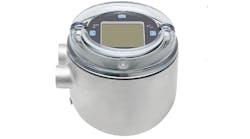When Coriolis flow measurement technology first debuted back in the 1970s, food and beverage companies were among the earliest adopters due to the meters' ability to directly, reliably and nonintrusively measure mass flowrates of a broad variety of substances over wide ranges—without stopping to recalibrate or reconfigure.
And since that time, those same Coriolis innovators that brought the first meters to market have continued to develop and introduce new capabilities that resonate with the very latest needs and priorities of food and beverage companies.
To learn how Emerson continues to pioneer Coriolis technology to align with the needs of today’s food and beverage companies, Control caught up with Melissa Stiegler, director, food and beverage industry for Emerson.
Director, Food & Beverage Industry, Emerson
Q: While successive generations of Emerson Coriolis sensors have certainly become more stable and even more accurate, many of the portfolio's innovations have had to do with associated software and analytics capabilities. Can you explain some of those innovations and their relevance to the food and beverage sector?
A: At the end of the day, if a customer has data but doesn’t know how to use it, it doesn’t help them. A lot of our innovations over the years have worked on just that. The most obvious one would be concentration measurement, which uses density and temperature to assess the concentration of a solution. If you think about a customer who's blending a beverage, they're probably using syrup at some point in the process. If they miss the target and put in too much or too little syrup, it affects the quality and taste of the end product. But with our Coriolis meters, they can instead use real-time concentration measurements to adjust blend rates on the fly. As you can imagine, the cost of concentrates, sugars, sweeteners and other ingredients are pretty high, so over-shooting specifications will really cost a lot and result in inconsistent product as well.
The other big hit for food and beverage companies has been Advanced Phase Measurement, which can help measure and remediate two-phase flows. What this means for our customers is that they can get much more accurate measurements of substances with entrained gas or liquid. Something like cream, which can be very foamy, can be tough to measure reliably.
Advanced Phase Measurement adapts to changing process conditions by using a proprietary algorithm to determine when there's entrained gas in the process. When gas is present, the smart solution automatically corrects mass and volume flow measurements based on previously measured gas-free values. We’ve had customers use it with ice cream, dog food and potato chip production—you name it, we’ve done it!
One final innovation to highlight would be Smart Meter Verification, which we launched in 2011. This is a “stoplight” type of check for your meter. It provides in-process verification of flowmeter health, giving customers confidence in their measurements. They can run these checks on-demand or schedule them to run consistently and identify trends in their meters to help them stay proactive on maintenance and maximize productivity. These tests can be done remotely as well, especially with our Ethernet transmitters such as the 1600 or 5700 that include built-in webservers.
What’s really important here is that we've spent a lot of time and energy innovating new solutions to help meet the needs of food and beverage customers. Technology leadership is much more than a portfolio of products; it's working with customers to resolve process issues that may not be a meter problem but the process itself causing a measurement problem. That’s what you get when you work with Emerson.
Q: While the COVID-19 pandemic was a wakeup call for all sorts of manufacturing companies, the food and beverage industry could ill afford to miss a beat. Can the type of flowmeter you buy play a role in boosting productivity and avoiding unnecessary downtime?
A: The pandemic definitely impacted the food industry; it changed the way that consumers consume things. For example, if you would regularly meet friends for happy hour at a bar, that stopped, and you had a drink at home and maybe meet via Zoom. While that change seems small, the necessary mix of cans of beer vs. kegs shifted dramatically. Costs changed, as did shipping and packaging requirements. Luckily, we all still have to eat and drink, and these producers were able to adjust to the trends quickly and really change how they do business.
But to get back to your question, all the software and analytic capabilities of our modern Coriolis meters are especially designed to maintain quality of a customer’s product and maximize productivity. What we’re hearing from our customers is the need to adjust quickly to significant shifts in production volume, changes in recipes and changes in processing conditions—all while dealing with staffing shortages. This is where accurate mass measurement, consistent recipe quality and proactive maintenance become key parts of adjusting to evolving consumer habits, while boosting and maintaining high productivity.
Q: Traditionally, Coriolis meters required separate wiring for power and for communications. But now, the new Micro Motion 1600 Coriolis transmitter includes the option of Power over Ethernet (PoE), which avoids the need for an extra set of wires. What sort of impact does that have on installation effort and expense?
A: The most obvious benefit is being able to bring both data and power over one Ethernet cable that plugs directly into the 1600’s Ethernet port—with no wiring termination required! No separate power cabling saves the customer time, expense and complexity. There are, however, other benefits such as the flexibility and scalability of Power over Ethernet. If an already installed network switch doesn’t have PoE capability, it can be readily retrofitted with what’s called an injector, allowing the customer to use existing infrastructure, and decide where and when to retrofit older network switches. One of our field trial customers did exactly that and they loved it. It saved them hours on installation effort while being cost-effective.
Q: What other features of the 1600 transmitter make it a tailor-made fit for food and beverage applications?
A: The most obvious thing externally is that it's really lightweight and compact, which is important in food and beverage applications. We'll be offering the 1600 both in aluminum and stainless steel with a polycarbonate cover that's been tested to withstand even the most rigorous clean-in-place (CIP) processes. It also includes Smart Meter Verification, onboard historian and batching software as an option for customers who want to use their Coriolis transmitter as a batch controller.
Q: Sustainability initiatives are front and center for industrial companies of all types, and food and beverage companies are no exception. What role can Coriolis meters play in increasing efficiency and reducing waste?
A: Micro Motion Coriolis meters can play a big role in sustainability—specifically around processes that require a lot of water. CIP does its job by forcing cleaning and rinsing solutions through the production line’s piping, valves and tanks. A Coriolis transmitter can see how much of this is flowing through the system, and make sure the right amount (and not too much) is used. A Coriolis meter can also help diagnose process issues before they affect final quality, preventing product scrap and resultant water and energy usage.



